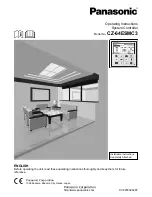
CSC-3000 Series Pneumatic VAV Reset Volume Controllers
7
Applications Guide, Rev G
Troubleshooting
NOTE: The controller should be set according
to the specifications found on the
manufacturer’s label on the VAV box.
NOTE: The CSC-3000 series are position sensitive.
Be sure to mount the controller with
the correct orientation. See
. If the controller is calibrated in a
position other than the final mounting
position, the calibration (minimum and
maximum flow limits) will be off.
NOTE: These controllers are typically used on
single-duct applications but may be
found in dual-duct applications. (See, for
Duct, Constant Volume on page 14
.) When
working on dual-duct applications it may
be necessary to work on one duct at a time.
Troubleshooting issues to consider include:
• Is there an adequate main air (M) supply?
• Is there adequate upstream system (duct) air?
• Is the application correct and piped correctly?
, and
.
• Is the damper action (NC/NO) set correctly? Do
the damper’s and controller’s action match? See
• Is the damper binding? Will the actuator drive
the damper full open to full close? (Sufficient
main air is required to provide the actuator with
enough force to operate the damper/linkage.) Is
the actuator leaking? (Even small leaks can cause
the actuator to not stroke. You can test for leaks
with a squeeze bulb to ensure there are no leaks
at the actuator diaphragm or fittings.)
• Does the thermostat send an adequate signal to
the controller?
• Are LO STAT and HI STAT set correctly for the
thermostat action? When cycled, can the control-
ler repeat the LO STAT and HI STAT settings? If
the LO STAT or HI STAT must be set for “0” wc,
see the notes about
zero minimum
Reset Minimum and Maximum on page 4
or
VERSE Reset Minimum and Maximum on page 5
Maintenance
No routine maintenance is required. Each compo-
nent is designed and manufactured for reliability
and performance. Careful installation and use will
ensure long-term dependability.
CAUTION
Pneumatic devices must be supplied with clean,
dry control air. Any other medium (e.g., oil
or moisture contamination) will result in the
device’s eventual failure.
• Is the airflow pickup properly placed, and does it
send a good differential pressure to the control-
ler? (See
.) Is the airflow
sensor dirty or defective? (Disconnect the sensor
from the controller before attempting to blow the
sensor clean!)
• Are reset start and reset span set correctly? See
.
Important Notices
The KMC logo is a registered trademark of KMC
Controls, Inc. All rights reserved. No part of this
publication may be reproduced, transmitted, tran-
scribed, stored in a retrieval system, or translated
into any language in any form by any means with-
out the written permission of KMC Controls, Inc.
The material in this document is for information
purposes only.
The contents and the product it de-
scribes are subject to change without notice.
KMC
Controls, Inc. makes no representations or warran-
ties with respect to this document. In no event shall
KMC Controls, Inc. be liable for any damages, direct
or incidental, arising out of or related to the use of
this document.

































